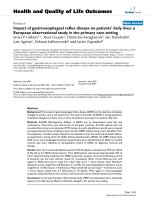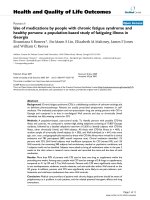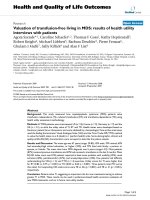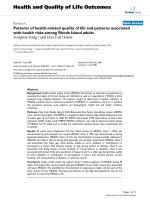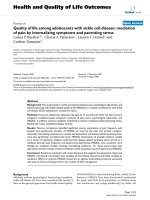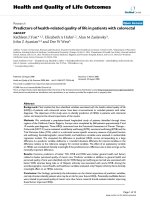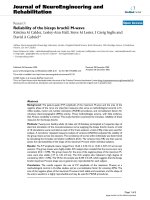báo cáo hóa học: " Valuation of transfusion-free living in MDS: results of health utility interviews with patients" ppt
Bạn đang xem bản rút gọn của tài liệu. Xem và tải ngay bản đầy đủ của tài liệu tại đây (256.1 KB, 8 trang )
BioMed Central
Page 1 of 8
(page number not for citation purposes)
Health and Quality of Life Outcomes
Open Access
Research
Valuation of transfusion-free living in MDS: results of health utility
interviews with patients
Agota Szende*
1
, Caroline Schaefer
1,2
, Thomas F Goss
2
, Kathy Heptinstall
3
,
Robert Knight
4
, Michael Lübbert
5
, Barbara Deschler
5
, Pierre Fenaux
6
,
Ghulam J Mufti
7
, Sally Killick
8
and Alan F List
9
Address:
1
Covance, Leeds, UK,
2
Covance, Gaithersburg, MD, USA,
3
MDS Foundation, Crosswicks, NJ, USA,
4
Celgene Corporation, Summit, NJ,
USA,
5
University of Freiburg, Freiburg, Germany,
6
Hôpital Avicenne, University of Paris XIII, Bobigny, France,
7
King's College Hospital, London,
UK,
8
Royal Bournemouth Hospital Foundation Trust, Bournemouth, UK and
9
University of South Florida, Tampa, FL, USA
Email: Agota Szende* - ; Caroline Schaefer - ;
Thomas F Goss - ; Kathy Heptinstall - ; Robert Knight - ;
Michael Lübbert - ; Barbara Deschler - ; Pierre Fenaux - ;
Ghulam J Mufti - ; Sally Killick - ; Alan F List -
* Corresponding author
Abstract
Background: This study measured how myelodysplastic syndrome (MDS) patients value
transfusion independence (TI), reduced transfusions (RT) and transfusion-dependence (TD) using
health utility assessment methodology.
Methods: 47 MDS patients were interviewed, US (n = 8), France (n = 9), Germany (n = 9) and the
UK (n = 21), to elicit the utility value of TI, RT and TD. Health states were developed based on
literature; patient forum discussions; and were validated by a hematologist. Face-to-face interviews
used the feeling thermometer Visual Analogue Scale (VAS) and the Time Trade-Off (TTO) method
to value the health states on a 0 (dead) to 1 (perfect health) scale. Socio-demographic, clinical, and
quality-of-life (EQ-5D) characteristics were surveyed to describe the patient sample.
Results and Discussion: The mean age was 67 years (range: 29-83); 45% male, 70% retired; 40%
had secondary/high school education, or higher (32%), and 79% lived with family, a partner or
spouse, or friends. The mean time from MDS diagnosis was 5 years (range:1-23). Most patients
(87%) received previous transfusions and 49% had received a transfusion in the last 3 months. Mean
EQ-5D index score was 0.78; patients reported at least some problem with mobility (45%), usual
activities (40%), pain/discomfort (47%), and anxiety/depression (34%). Few patients had difficulty
understanding the VAS (n = 3) and TTO (n = 4) exercises. Utility scores for TI were higher than
for RT (0.84 vs. 0.77; p < 0.001) or TD (0.84 vs. 0.60; p < 0.001). Three patients rated TD worse
than dead. Corresponding VAS scale scores were 78 vs. 56; (p < 0.001), and 78 vs. 31 (p < 0.001),
respectively.
Conclusion: Patients value TI, suggesting an important role for new treatments aiming to achieve
greater TI in MDS. These results can be used in preference-based health economic evaluation of
new MDS treatments, such as in future cost-utility studies.
Published: 8 September 2009
Health and Quality of Life Outcomes 2009, 7:81 doi:10.1186/1477-7525-7-81
Received: 12 November 2008
Accepted: 8 September 2009
This article is available from: />© 2009 Szende et al; licensee BioMed Central Ltd.
This is an Open Access article distributed under the terms of the Creative Commons Attribution License ( />),
which permits unrestricted use, distribution, and reproduction in any medium, provided the original work is properly cited.
Health and Quality of Life Outcomes 2009, 7:81 />Page 2 of 8
(page number not for citation purposes)
Background
Myelodysplastic syndromes (MDS) is a term used to
describe a group of diseases characterized by ineffective
hematopoiesis leading to blood cytopenias and hypercel-
lular bone marrow. MDS has traditionally been consid-
ered to be synonymous with 'preleukemia' because of the
increased risk of transformation into acute myelogenous
leukemia (AML)[1]. Debilitating symptoms of MDS
include fatigue, pallor, infection, and bleeding; with com-
monly associated laboratory findings of anemia, neutro-
penia, and thrombocytopenia [2,3]. Due to its low
incidence and nature, MDS is recognized as an orphan
disease by regulatory authorities in Europe and the US.
The majority of MDS patients is unable to maintain nor-
mal levels of hemoglobin and is anemic. Consequently, a
large proportion of patients rely on frequent red blood
cell (RBC) transfusions. While there is currently no widely
accepted definition of "transfusion-dependence" with
respect to the number and frequency of units received,
estimates of the proportion of MDS patients who are
transfusion dependent can be up to 80 percent, depend-
ing on the type of MDS and disease severity [4]. The Inter-
national Working Group (IWG) originally standardized
response criteria for MDS classifies achieving transfusion
independence as a major hematologic improvement and
achieving a 50% reduction in transfusions as a minor
erythroid response[5].
As new treatments have become available, such as azacit-
adine for patients with intermediate 2 or high risk and
lenalidomide for transfusion-dependent anemia due to
Low- or Intermediate-1-risk MDS associated with a dele-
tion 5q cytogenetic abnormality, transfusion independ-
ence has become a key treatment objective in everyday
clinical practice. Transfusion independence has been asso-
ciated with a positive impact on health-related quality of
life (HRQOL). [6,7] Transfusion independence was also
shown to increase the likelihood of survival in a recent ret-
rospective analysis of MDS patients [8].
However, research is lacking on the valuation of health
states associated with transfusion independence as
opposed to transfusion dependence in MDS patients. The
objective of this study was to elicit how MDS patients
value transfusion independent living compared to trans-
fusion dependence using validated health utility assess-
ment methods.
Methods
We performed health utility interviews [9] with a total of
47 MDS patients in France, Germany, the United King-
dom (UK), and the United States (US) to elicit the value
of transfusion independence or reduced transfusion bur-
den compared to transfusion dependence (i.e., three dis-
tinct health states).
The interviews were performed at one site in each country,
except the UK where there were two sites. In Europe, the
site selection was facilitated by the MDS Foundation
through several of its participating clinical centers that
specialize in treating MDS (Paris, Freiburg, London,
Bournemouth). In the US, patients were recruited in the
Washington, DC area by the Aplastic Anemia MDS Group.
Patients had to be currently diagnosed with MDS and be
able to read and communicate in the local language. Prior
to participating in the research, patients were provided
with an information sheet explaining the purpose of the
research, and asked to provide written informed consent.
Interviews were conducted during the last quarter of 2005
and during 2006.
Health state descriptions were developed based on litera-
ture and reports from MDS patient forum discussions,
and were validated by a leading clinical expert in the diag-
nosis and treatment of MDS. A qualitative summary was
produced including key concerns that patients commonly
brought up in relation to limitations they experienced in
various aspects of their HRQOL.
Each health state card included different levels of severity/
intensity of problems on the following specific aspects of
main HRQOL domains: reliance on blood transfusions
and health care provider facility; need to arrange one's life
around medical appointments; fatigue and tiredness that
limits performance of routine physical activities; interfer-
ence of disease with social and family life; worry about the
future due to health condition; discomfort associated with
medical conditions and treatment, and the feeling of
being at risk of infection; reliance on support persons for
self care and routine activities; feelings of being a burden
to family; and feeling sad, hopeless, and helpless.
Table 1 includes the description of the transfusion inde-
pendent state and transfusion dependent state.
The feeling thermometer Visual Analogue Scale (VAS) and
the Time Trade-off (TTO) methods were used in face-to-
face interviews to value the health states on a scale
anchored on 1 (perfect health) and 0 (dead) [10-12]. In
the first six patients, the Standard Gamble (SG) method
also was administered on a pilot basis together with the
TTO, but was then discontinued due to the high rate of
patients who did not comprehend the exercise in this pre-
dominantly elderly patient population.
In this study, the main aim of the VAS exercise was to help
respondents to familiarize themselves with the health
states at the beginning of the interview. However, VAS
Health and Quality of Life Outcomes 2009, 7:81 />Page 3 of 8
(page number not for citation purposes)
results were also reported separately. The visual prop used
was a vertical thermometer-shaped scale, 55 cm long, and
numerically scaled in units from 0 to 100. The health
states to be rated were printed on cards. The patients were
asked to assume that all other aspects of health were nor-
mal. They were then asked to place the health states at any
point on the scale to correspond to their preferences for
these health states.
The TTO part of the interview used a specifically-designed
board for the valuation of each MDS condition with vary-
ing levels of transfusion dependence. Patients were asked
to make a set of paired comparisons between living in the
MDS health state for five years, or in perfect health for a
shorter period of time. We opted to use five years in the
exercise, instead of the most typically used ten-year
period, to make the exercise more realistic, given the age
and life expectancy of MDS patients. Periods of time in
perfect health were varied by 0.5 years. At the point of
indifference, where the respondent was unable to choose
between 5 years in the MDS health state and the period of
perfect health on offer, a utility score was assigned to the
MDS state by estimating the ratio of the time in perfect
health on offer to the time in the MDS health state. In
cases when the respondent had a clear preference between
cards but was not willing to sacrifice an additional 0.5
units of time off perfect health, a midpoint score was
assigned.
Within each exercise, patients first rated transfusion inde-
pendence and reduced transfusion health states on the
'perfect health' and worst MDS state (that is, transfusion
dependence state) scale, and then rated the transfusion
dependence state on the 'Perfect Health' and 'Dead' scale.
The 'chain utility assessment' method was then used to
calculate utility scores for each MDS health state (i.e., first
anchoring scores on the 'perfect health' and worst MDS
scale, and then re-scaling scores on the perfect health and
'dead' scale). As such, the resulted utility scores were
anchored on 1 (perfect health) and 0 (dead). The Wil-
coxon signed rank test was used to compare TTO utility
scores between MDS health states. We also described the
distribution of utility scores in order to inform probabil-
istic analyses to be performed around utilities in any
future cost-utility models.
We also administered background questionnaires on
socio-demographic, clinical, and HRQOL (using the
EuroQOL EQ-5D questionnaire) [13] characteristics to
describe the patient sample.
Results
Key patient demographic data are summarized in Table 2.
The majority of patients were retired (70%), had second-
ary/high school education (40%) or higher (32%), and
were living with family, a partner or spouse, or friends
(79%).
The mean time from MDS diagnosis was 5 years (range: 1-
23). The majority of patients received blood transfu-
sion(s) previously (87%), and 49% had received a blood
transfusion in the last three months.
Table 1: Health State Descriptions
Transfusion-independent state You rely on regular medications and routine medical checkups but you do not need to go to a health care facility
to receive blood transfusions.
You rarely feel that you need to arrange your life around medical appointments.
You rarely experience fatigue and tiredness that would limit you in performing routine physical activities.
Your disease rarely interferes with your social functioning and family life.
You occasionally have concerns about your future due to your health.
You periodically experience mild to moderate discomfort associated with health conditions and their
treatment, but you rarely feel that you are at risk of infections.
You can take care of yourself and routine activities most of the time. You rarely feel that you are a burden to
your family due to your health condition.
You often feel positive, motivated, and in control of your life despite your health condition.
Transfusion dependent state You rely on regular blood transfusions and need to spend significant time at a health care provider facility. You
depend on availability and accessibility of health care facilities and your health care providers.
You often feel that you need to arrange your life around medical appointments.
You often experience fatigue and tiredness that limits you in performing routine physical activities.
Your disease often interferes with your social functioning and family life.
You often worry about your future due to your health.
You experience moderate to severe discomfort associated with health conditions and their treatment, and
feel that you are at risk of infections.
You rely on family or other caregiver support as you frequently may need assistance to take care of yourself
and routine activities. You may often feel that you are a burden to your family due to your health condition.
You often feel sad, hopeless, and helpless because of your health condition.
Health and Quality of Life Outcomes 2009, 7:81 />Page 4 of 8
(page number not for citation purposes)
The mean EQ-5D index value was 0.78 for the patients in
our sample, and patients reported at least some problem
with mobility (45%), usual activities (40%), pain/dis-
comfort (47%), and anxiety/depression (34%). One
patient reported problems with self-care. Patients valued
their own health as 0.86 with the TTO method and 0.62
with the VAS method on the 'Perfect Health' and 'Dead'
scale.
In the pilot sample of 6 patients, 3 patients did not com-
prehend the SG exercise and hence this method was dis-
continued in the rest of the study. In the overall sample,
few patients had difficulty understanding the VAS (n = 3)
and TTO (n = 4) exercise.
Among valid responses, the transfusion-independent
health state was preferred over health states with transfu-
sion requirements using both the VAS and TTO methods
(Table 3).
Paired T-tests showed that VAS scores were statistically sig-
nificantly higher for the transfusion independent state
compared to health states with reduced transfusion
requirements (78 vs. 56; p < 0.001) and transfusion
dependence (78 vs. 31; p < 0.001). The Wilcoxon signed
rank test showed that corresponding TTO scores were 0.84
vs. 0.77 (p < 0.001), and 0.84 vs. 0.60 (p < 0.001), respec-
tively. Using the TTO method, three patients valued trans-
fusion dependence as worse than being dead.
Similar results were observed across countries (Table 4).
Differences in utility scores between the transfusion inde-
pendent and transfusion dependent health states were sta-
tistically significant in each country (p < 0.05). However,
the difference between health states of transfusion inde-
pendence and reduced transfusion requirement only
reached statistical significance in the UK sample (p =
0.005).
When excluding responses where patients evaluated all
three health states the same (n = 9), TTO-based utility
scores for the transfusion independence, reduced transfu-
sion, and transfusion dependence health states in the
overall sample were 0.82, 0.73, and 0.52, respectively (p <
0.001).
The frequency of TTO-based utility scores assigned to the
three MDS health states are shown in Figure 1. The most
frequent utility scores were 0.95 for both the transfusion
independence (n = 24) and the reduced transfusion (n =
15) health states. These were responses that reflected a
clear preference for perfect health over the MDS health
state but responders were not willing to accept a 0.5 year
loss in length of life to achieve perfect health, and hence a
midpoint of 0.95 utility score was assigned. For the trans-
fusion dependence health state, the most frequently
reported utility scores were 0.75 (n = 8) and 0.45 (n = 8).
Discussion
This study fills in a gap in research by eliciting health util-
ity scores for MDS health states for the first time. Below we
discuss the interpretation of actual results, patient sample
issues, and methodological considerations.
Interpretation of results
Previous HRQOL studies have showed that patients with
MDS experience impairment in functioning and activities
of daily living that result in worse HRQOL than those of
Table 2: Patient Demographic Characteristics
Age (range) 67 (29-83) years
Gender 45% male
Country of origin
US 17% (n = 8)
France 19% (n = 9)
Germany 19% (n = 9)
UK 45% (n = 21)
Table 3: Ratings for MDS Health States, All Countries
Health State Method
VAS Method Mean (SD) TTO Method Mean (SD)
Living in transfusion independence 78 (15) 0.84 (0.16)
Living with reduced transfusion burden 56 (16) 0.77 (0.21)
Living with transfusion dependency 31 (18) 0.60 (0.28)
*P-values for testing the difference between each pair of health states were lower than 0.001.
Health and Quality of Life Outcomes 2009, 7:81 />Page 5 of 8
(page number not for citation purposes)
similarly aged adults from the general population [14-16].
It was also shown that fatigue caused by chronic anemia
has a large impact on the overall HRQOL of MDS patients
[7,15]. Transfusion dependency and HRQOL also were
shown to be closely associated in MDS patients. Specifi-
cally, one cross-sectional study examined the association
between transfusion needs and HRQOL, using the dis-
ease-specific QOL-E questionnaire in 52 MDS patients
[6]. The study showed that even after partially controlling
for hemoglobin level and other clinical variables, the
number of transfusions per month was inversely corre-
lated with HRQOL. Patients who did not receive monthly
transfusions because their hemoglobin level was higher
than 8 g/dL had significantly higher overall HRQOL
scores than transfusion-dependent patients.
Our study results provide important new evidence that
independence from transfusions is not only associated
with better HRQOL scores but patients also put a high
value on being transfusion-free when their preferences are
measured on a utility scale. This finding is significant as it
indicates that transfusion dependency is regarded as 'bad
enough' by MDS patients to be willing to trade-off length
of life in order to achieve transfusion independence. The
sacrifices that patients were willing to make were the most
substantial for the transfusion dependence state reflected
by the 0.60 utility score.
While the our results for each pair of health states in the
overall sample and for the transfusion independent versus
transfusion dependent health states in each individual
Table 4: Ratings for MDS Health States by Country
Health State Method
VAS Method Mean (SD) TTO Method Mean (SD)
France
Living in transfusion independence 72 (16) 0.80 (0.16)
Living with reduced transfusion burden 66 (12) 0.70 (0.22)
Living with transfusion dependency 44 (18) 0.56 (0.34)
Germany
Living in transfusion independence 78 (10) 0.80 (0.23)
Living with reduced transfusion burden 52 (13) 0.75 (0.21)
Living with transfusion dependency 23 (18) 0.50 (0.27)
UK
Living in transfusion independence 76 (16) 0.85 (0.15)
Living with reduced transfusion burden 51 (16) 0.77 (0.24)
Living with transfusion dependency 30 (16) 0.65 (0.29)
US
Living in transfusion independence 90 (7) 0.91 (0.07)
Living with reduced transfusion burden 58 (19) 0.84 (0.10)
Living with transfusion dependency 26 (19) 0.61 (0.20)
*P-values for testing the difference between each pair of health states were lower than 0.05. Exceptions were found for the comparison between
the transfusion independent and the reduced transfusion health states in the US sample (p = 0.07), the French sample (p = 0.07), and the German
sample (p = 0.11).
Health and Quality of Life Outcomes 2009, 7:81 />Page 6 of 8
(page number not for citation purposes)
country were statistically highly significant, the observed
difference between the transfusion independent and
reduced transfusion requirement health states was only
statistically significant in the UK country sample. For this
reason, the use of country specific MDS utility scores
should be carefully considered and analyst may decide to
use the pooled results in base case or sensitivity analysis in
economic evaluations in countries where differences did
not reach statistical difference between each pair of health
states.
Although there is a lack of utility studies in MDS with
which to compare our results, comparison of MDS health
states with utility scores for the general population can be
made with some limitations. Comparability is limited by
the fact that patients tend to report better scores for dis-
ease states than would a person from the general popula-
tion without the condition. In addition, available utility
norms for general populations were elicited with the TTO-
based generic utility questionnaire, the EQ-5D, instead of
using direct TTO assessments like our study did. Neverthe-
less, average health utility scores for the general popula-
tion were reported as 0.86 and 0.87 for the UK and the US,
respectively [17,18]. Corresponding utility scores for peo-
ple between the age of 65-74 were 0.78 and 0.82, respec-
tively. The comparison between these utility scores and
those for MDS health states from our study confirms that
transfusion-dependent MDS is valued as a condition with
substantially reduced health status.
Patient sample issues
Studies involving MDS patients, especially those on
health outcomes, have traditionally captured small sam-
ples of patients due to the rareness of the condition and
the lack of new treatments under evaluation. MDS
patients are typically treated in centers that specialize in
MDS. We tried to achieve a reasonably representative sam-
ple of MDS patients from a selection of these centers that
also represent cultural differences across four countries
and demographic characteristics, such as age and gender.
Despite these efforts and achieving results that are statisti-
cally significant, some limitations need to be noted. The
US sample was recruited from a patient organization. As
such, these patients may have not been fully representa-
tive of the overall patient population. Members of patient
Distributional Characteristics of TTO Ratings for MDS Health StatesFigure 1
Distributional Characteristics of TTO Ratings for MDS Health States.
Health and Quality of Life Outcomes 2009, 7:81 />Page 7 of 8
(page number not for citation purposes)
organizations may be milder in disease severity and may
represent different views than non-members. Data from
the administration of the background HRQOL question-
naire, the EQ-5D, suggested that MDS patients in our sur-
vey may had currently a milder MDS disease severity as
their EQ-5D scores were only somewhat worse than that
of the general population. While most patients came from
the elderly age groups typical in MDS, there were two
patients in the UK who were unusually young for MDS
(32 and 33 years old). Our sample also seemed to include
a lower transfusion-dependency rate than observed in
many MDS sub-types with 49% of patients receiving a
transfusion in the past 3 months. However, 87% of
patients in our sample had received blood transfusion
before, suggesting that they were able to give informed
responses when rating the transfusion dependency health
state.
The administration of the background HRQOL question-
naire also enabled us to compare our patient sample with
that of the general population. As expected, our patient
sample presented worse HRQOL ratings than the general
population. For example, the proportion of people report-
ing at least some problem in a comparable age-group
from a UK-based general population sample was lower
than observed in our sample, including rates of reported
problems of 29% (mobility), 25% (usual activity), 46%
(pain/discomfort) and 28% (anxiety/depression) [19].
Methodology considerations
To elicit health utility values associated with health states,
a number of different methods exist. These methods can
differ in key aspects such as the preference elicitation tech-
nique used or the sample whose values are measured [20].
The main utility results that our study reported were based
on the TTO method, which is one of the two most widely
accepted choice-based valuation techniques [12]. In inter-
preting results, one needs to bear in mind that utility
scores using other methods may have given different
scores. Specifically, as noted in the literature, the SG tech-
nique typically yields higher, while the VAS technique typ-
ically yields lower, ratings than does the TTO technique
[21]. Our results on lower VAS scores than TTO scores for
MDS health states were consistent with this general find-
ing. Patients' valuation of their own current health also
yielded consistently higher values with the TTO method
compared to VAS.
We note that variations within utility elicitation methods
also exist regarding the exclusion criteria used for valid
responses or the valuation of health states worse than
'dead'. Specifically, the base-case results of our study
included responses that gave the same TTO ratings for
each of the three health states, as long as the respondent
comprehended the exercise. However, we also reported
that utility scores for each health state were lower when
these responses were excluded. Utility scores that we
reported for this scenario may be of interest to those who
believe that the TTO method should be able to differenti-
ate preferences for different health states in each respond-
ent. Health states regarded worse than dead were assigned
a utility score of zero in our study. Should a method that
assigns negative scores to these valuations have been
applied, scores for the RT and in particular for the TD state
would have been even lower than reported here.
There also is a debate regarding whose values utility scores
should reflect. Some researchers argue that valuations by
patients are more informed as they have direct knowledge
of the condition; while others advocate that views of the
general population should be taken into account when
utility results are used to inform resource allocation in
public health care systems [20]. In practice, utility valua-
tion studies on disease-specific health states are more
often done in the respective patient sample, like our study
did. However, our results may be interesting to compare
with utility scores gained via generic utility instruments
that reflect the general public's values and are adminis-
tered among MDS patients in any future studies of that
nature.
Conclusion
The results of this study show that patients associate a
high value with achieving transfusion independence in
MDS. These findings suggest an important role for new
treatments aimed at achieving greater transfusion inde-
pendence in MDS. New health utility values elicited in
this study could be used in health economic evaluations
of emerging MDS treatments that express and compare
the health outcome of therapies in quality-adjusted life
years (QALYs).
Competing interests
The authors declare that they have no competing interests.
Authors' contributions
AS prepared study design, developed MDS health state
descriptions, carried out study, analysis, and report prep-
aration. CS carried out study, analysis, and report prepara-
tion. TFG developed MDS health state descriptions and
carried out the analysis. KH carried out the study. RK con-
tributed to the study design. ML carried out the study. BD
carried out the study. PF carried out the study. GJM carried
out the study. SK carried out the study. AFL developed
MDS health state descriptions and contributed to study
design. all authors read and approved the final manu-
script.
References
1. List AF, Vardiman J, Issa JP, DeWitte TM: Myelodysplastic syn-
dromes. Hematology Am Soc Hematol Educ Program 2004:297-317.
Publish with BioMed Central and every
scientist can read your work free of charge
"BioMed Central will be the most significant development for
disseminating the results of biomedical research in our lifetime."
Sir Paul Nurse, Cancer Research UK
Your research papers will be:
available free of charge to the entire biomedical community
peer reviewed and published immediately upon acceptance
cited in PubMed and archived on PubMed Central
yours — you keep the copyright
Submit your manuscript here:
/>BioMedcentral
Health and Quality of Life Outcomes 2009, 7:81 />Page 8 of 8
(page number not for citation purposes)
2. Faderl S, Kantarjian HM: Novel therapies for myelodysplastic
syndromes. Cancer 2004, 101(2):226-241.
3. Cortes J, List A, Kantarjian H: Myelodysplastic syndromes. In
Cancer management: a multidisciplinary approach: medical, surgical, &
radiation oncology 8th edition. Edited by: Pazdur R, Hoskins W, Coia L,
Wagman L. New York: Oncology Group; 2004:801-818.
4. Brechignac S, Hellstrom-Lindberg E, Bowen DT, DeWitte TM, Caz-
zola C, Fenaux P: Quality of Life and Economic Impact of Red
Blood Cell (RBC) Transfusions on Patients with Myelodys-
plastic Syndromes (MDS). ASH Annual Meeting Abstracts 2004,
104(11):4716.
5. Cheson BD, Bennett JM, Kantarjian H, Pinto A, Schiffer CA, Nimer
SD: Report of an international working group to standardize
response criteria for myelodysplastic syndromes. Blood 2000,
96(12):3671-3674.
6. Oliva E, Dimitrov B, D'Angelo A, Martino B, Perna A, Nobile F: QOL-
E: A new tool for the assessment of quality of life in myelod-
ysplastic syndrome. Blood 2001, 98(11 Pt 1):427a.
7. Spiriti MA, Latagliata R, Niscola P, Cortelezzi A, Francescani M, Fer-
rari D: Impact of a new dosing regimen of epoetin alfa on
quality of life and anemia in patients with low-risk myelodys-
plastic syndrome. Ann Hematol 2005, 84(3):167-176.
8. Malcovati L, Porta MG, Pascutto C, INvernizzi R, Boni M, Travaglino
E: Prognostic factors and life expectancy in myelodysplastic
syndromes classified according to WHO criteria: a basis for
clinical decision making. J Clin Oncol 2005, 23(30):7594-7603.
9. Torrance GW: Measurement of health state utilities for eco-
nomic appraisal. J Health Econ 1986, 5(1):1-30.
10. Torrance GW: Utility approach to measuring health-related
quality of life. J Chronic Dis 1987, 40(6):593-603.
11. Furlong W, Fenny D, Torrance A: Guide to Design and Development of
Health-State Utility Instrumentation Hamilton, Ontario: McMaster Uni-
versity; 1990.
12. Drummond M, McGuire A: Economic Evaluation in Health Care 1st edi-
tion. Oxford University Press; 2001.
13. The EuroQoL Group: EuroQol a new facility for the measure-
ment of health-related quality of life. The EuroQol Group.
Health Policy 1990, 16(3):199-208.
14. Thomas ML: Quality of life and psychosocial adjustment in
patients with myelodysplastic syndromes. Leuk Res 1998,
22(Suppl 1):S41-47.
15. Jansen AJ, Essink-Bot ML, Beckers EA, Hop WC, Schipperus MR,
Rhenen DJ: Quality of life measurement in patients with trans-
fusion-dependent myelodysplastic syndromes. Br J Haematol
2003, 121(2):270-274.
16. Hellstrom-Lindberg E, Gulbrandsen N, Lindberg G, Ahlgren T, Dahl
IM, Dybedal IA: validated decision model for treating the anae-
mia of myelodysplastic syndromes with erythropoietin +
granulocyte colony-stimulating factor: significant effects on
quality of life. Br J Haematol 2003, 120(6):1037-1046.
17. Kind P, Hardman G, Macran S: UK Population Norms for EQ-5D The
University of York. Centre for Health Economics. Discussion Paper
172.
18. Coons S, Shaw J, Johnson J: The Measurement and Valuation of
Health in the US: The EQ-5D Approach. Proceedings of the
Annual EuroQol Group Meeting 2005.
19. Kind P, Dolan P, Gudex C, Williams A: Variations in population
health status: results from a United Kingdom national ques-
tionnaire survey. Bmj 1998, 316(7133):736-741.
20. Szende A, Schaefer C: A taxonomy of health utility assessment
methods and the role for uncertainty analysis. Eur J Health
Econ 2006, 7(2):147-151.
21. Green C, Brazier J, Deverill M: Valuing health-related quality of
life. A review of health state valuation techniques. Pharmac-
oeconomics 2000, 17(2):151-165.

